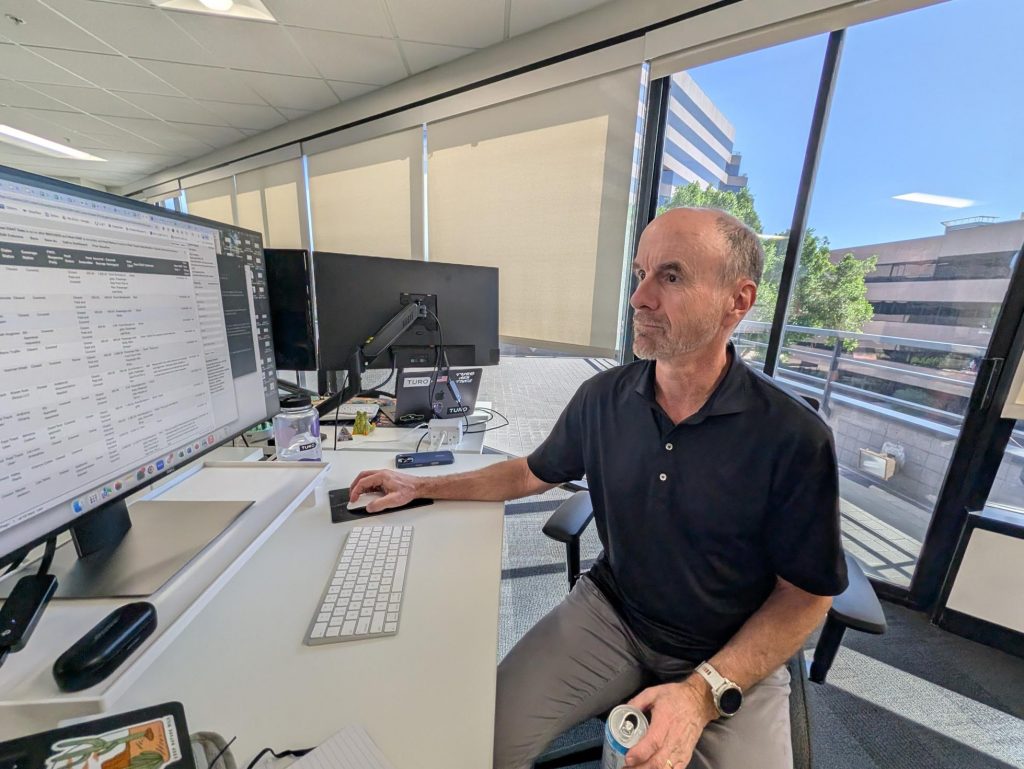Seasoned travelers know the ritual: a slow walk around the rental car, phone out, snapping pictures before hitting the road.
They have good reason. Most major rental companies still use opaque systems to assign blame for new scratches.
This disconnect between the customer’s proof and the company’s process is at the heart of Hertz’s latest controversy. The company is now using automated scanning systems from Israeli startup UVeye to catalog vehicle damage — and then bill customers.
Hertz claims its digital inspections bring “precision, objectivity, and transparency” to this age-old friction point. Travelers burned by surprise bills aren’t convinced.
But one one of the most effective solutions is right in your pocket.
Peer-to-peer car-sharing platform Turo built its entire business on this idea. From the start, it has practically required both hosts and guests to upload time-stamped photos of the vehicle before and after each trip. When damage claims arise, the pictures — not an algorithm or a corporate billing department — tell the story.
It’s a low-tech approach that has quietly solved one of the rental industry’s biggest headaches: trust.
So why aren’t the major car rental companies asking customers to do the same?
Hertz bets on automation
Early this year, Hertz rolled out digital vehicle inspections at select U.S. locations. The system scans each car at pickup and return, capturing hundreds of images of the body, tires, and glass. Those images feed a machine-learning model that flags new damage when the car is returned.
If Hertz detects damage to the vehicle, customers receive before-and-after photos and a report. The system got off to a rough start, apparently billing customers automatically without much human oversight. Hertz now says human agents make the final assessment and customers can dispute charges by submitting their own photos.
“Of the nearly one million rentals scanned so far, more than 97 percent showed no billable damage,” Hertz spokeswoman Lauren Luster says.
Hertz says data, third-party audits, and continuous AI retraining are the backbone of the process.
“Our goal is to enhance the safety, quality, and reliability of our fleet and create a more consistent rental experience,” Luster says.
Other rental companies remain cautious.
Enterprise, which also owns National and Alamo, still relies on human agents for determining damage claims. A representative says it “actively encourages” renters to be engaged in its vehicle inspection process and “welcomes customers taking their own pictures.”
“While we are not currently employing the use of advanced imaging technology as part of the rental process, we are exploring all options to ensure the most consistent and best customer experience,” says Enterprise spokesman Michael Wilmering.
Turo takes the opposite approach
Turo’s app has always prompted both hosts (car owners) and guests (renters) to take photos before and after each trip. Those pictures — dozens of them, ideally — form the backbone of its damage adjudication system.
“It’s protection for both parties,” says Jeff Platt, the company’s chief insurance officer.
Turo’s process is surprisingly low-tech. Every claim is reviewed by a human, sometimes with AI assistance to compare images. But the photos themselves — not a scanner or algorithm — decide the case.
“We’ve tested machine-learning tools,” says Platt. “But the real world conditions aren’t perfect. Cars are parked in the dark, in snow, or next to other vehicles. For now, humans still do a better job of spotting damage.”
A human, for instance, can tell the difference between a new scratch and bird droppings; AI might just bill you for a new paint job.
The result of Turo’s photo requirement is a faster resolution and fewer disputes. When both sides have clear, time-stamped photos, it’s easier to tell what happened, and what didn’t. Most claims are settled quickly, often without escalating to an insurance company — or a consumer advocate.
Why don’t car rental companies integrate a photo system in their apps?
“It would make their process much more transparent,” says Platt.
But he and other Turo executives suggest it’s about control and revenue. The system might cost car rental companies money from unsuccessful damage claims. When clear “before” and “after” photos exist, the company loses control of the narrative and the billing. That, perhaps, is the real reason it hasn’t been implemented.
Transparency by hand — not by machine
There’s the irony: two models, one built on cutting-edge AI, the other on simple photos, both claiming to deliver transparency. The key difference is control.
With Hertz’s system, transparency is mediated through a machine, then interpreted by the company. With Turo’s, it’s literally in the renter’s hands.
There’s no mystery, no proprietary database — just a timestamped record everyone can see.
Even Turo is wary of letting AI make the final call.
“We don’t trust AI completely at this stage as it’s not perfect and it’s not always accurate,” says Platt.
In an era obsessed with automation, Turo’s insistence on human judgment feels almost old-fashioned. But it works.
The takeaway: document everything
The lesson for travelers is simple: take photos of your rental car. Lots of photos.
Whether you’re renting from Hertz, Enterprise, or a neighbor on Turo, those pictures are your only real defense against a false damage claim.
Hertz and Enterprise say customers are welcome to document their vehicle’s condition. Yet few renters do it unless actively prompted. The ones who do rarely lose the fight when presented with a damage bill.
Transparency in car rentals may not require more technology — just more diligence. Until AI can understand context, fairness, and the difference between pre-existing damage and a smudge, your phone camera remains the best protection you’ve got.

